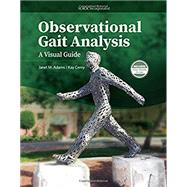This visual guide by Drs. Jan Adams and Kay Cerny has unique features to further the understanding of examination and evaluation of the subject’s gait, such as:
- Normal and pathological gait are described using figures and graphs, along with gait videos and 3D graphs to show the kinematics and kinetics described
- Functional tools used as outcome measures to evaluate gait performance in the community environment including Dynamic Gait Test, Six Minute Walk Test, Ten Meter Walk Test, to name a few
In addition to the unique features, the pathological gait section presents descriptions of gait deviations included in a new clinical Observational Gait Analysis (OGA) tool, along with probable causes for each of the deviations. Case studies are presented using this new tool for examining and evaluating the subject’s gait.
Bonus!
Students will be able to watch antero-posterior and lateral videos of individuals with gait deviations, complete the OGA tool to document their gait examination, and evaluate their examination results. They will then validate their observational skills by comparing their results to the text’s case study OGA results and the skeletal model and motion and moment graphs completed by 3D instrumented analysis of the same individual. The student will then compare their evaluation of causes of deviations to that included in the case study.
Instructors in educational settings can visit www.efacultylounge.com for additional materials to be used in the classroom.
Observational Gait Analysis: A Visual Guide will be the go-to resource for clinical tools to analyze gait for physical therapy and prosthetic and orthotic students and clinicians, as well as other professionals interested in the clinical analysis of persons with gait disability.








